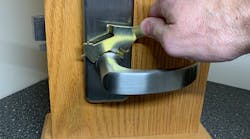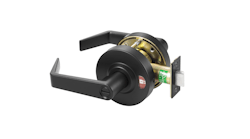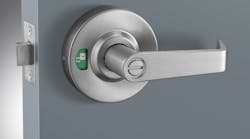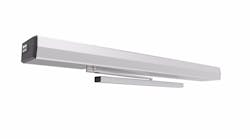Lock installations are a constant source of work for most residential and commercial security professionals. Knobs, levers, deadbolts and rim locks all require a decent set of hole saws, fly bits and maybe a handy installation jig or template.
If you ever get caught on the job without a jig, installing a cross-bore cylindrical lock is still a matter of ease.
Mortise lock installations present a different challenge. Although you may not install them as often as cross-bore locks, they still need to be considered a standard type of lock you need to install in a blank door or in a retrofit situation.
Free-hand drilling of a mortise pocket on a blank door is not recommended by most locksmiths. If you’ve ever done it, you already know why.
In addition to trying to keep the depth and width cuts within the proper parameters, it is extremely time consuming. After the pocket length and width is determined, a series of fly bit, auger or similar cuts are made to the approximate depth. This action requires some caution because the holes have to overlap to leave a minimum amount of remaining material. Keeping the holes square to the door edge is difficult.
After the series of holes is drilled you must try to remove the remaining wood by free-hand drill positioning the bit between the original holes or by a long series of chisel cuts. Likewise, trying freehand to enlarge a small mortise pocket used for a bit lock to a larger pocket for a full sized mortise lock is time consuming and risky.
Keeping the chisel aligned to remove enough wood takes additional time. Since any amount of material removed weakens the door, it is essential to remove only what is necessary to properly install the lock body. A spinning fly bit in a hand held drill may do real damage. Either of these actions carries the risk of splitting the door, not removing enough wood or removing more material than necessary.
There are alternatives to free-hand installation, such as using a large plunge router and sophisticated drill guide combination. If you own one, you know how expensive it is to add it to your arsenal of tools. If you only rent one occasionally, you know it takes a while to understand how to use it correctly. Even though the expensive tool is designed specifically for installing mortise locks, if you don’t know how to use it correctly, it isn’t worth renting in the first place.
The use of a simple mortise jig makes the job easier and is more time efficient.
PRO-LOK has come up with a neat alternative tool. The INJIG-MORT mortise lock installation jig can be used to cut mortise pockets of varying sizes, faceplate mortises and (with the optional cutters and short boring shaft) can prep an aluminum door for an Adams Rite style storefront door lock.
The basic kit includes a molded carrying case, the jig apparatus, a long boring shaft with adjustable stop collar (for mortise lock bodies up to 6 inches deep) and three common sized wood boring cutters.
The heavy-duty jig incorporates a unique quick-change cutter, which allows swapping cutters without removing the jig from the door. This means the full lock body pocket and faceplate mortise can be cut out in a minimum amount of time.
The Mortise Jig cutters will cut a mortise pocket in hard wood, soft wood and composite doors and aluminum doors with the optional equipment – all in a short time.
The cutter is locked into the end of the boring shaft with a spring-loaded collar. The shaft runs in a sliding aluminum housing and is powered by a portable drill with a half-inch chuck. Although battery operated drills will work, the use of an electric corded drill may be desired to maintain sufficient torque during the pocket cutting process.
An adjustable collar on the boring shaft limits the depth of cutting into the mortise pocket, permitting cutting of the pocket and preventing excess depth cuts caused by freehand drilling.
After the pocket is cut, readjusting the stop to a minimum depth allows cutting the faceplate recess. The round cutter will leave radius corners on the faceplate mortise. The square corners are finished off with a standard chisel.
The knurled aluminum head is mounted on two hinged slides that move independently along the steel guides. The dual action of the guide head requires no adjustment or relocation by the installer.
During installation, the guide head is gripped by the knurled area and used to move the cutter in an up and down motion. With the cutter head removing a small amount of material with each pass, the chips will fall out of the way as the cutter passes. By putting slight inward pressure on the drill motor with each pass, another layer of wood is removed. Since the cutter shaft has a stop ring positioned at the final depth position, a rapid succession of inward motions as the head is moved up and down will result in the pocket being cut in a matter of minutes.
Because this is not a plunge router, Pro-Lok advises against trying to cut a full depth hole in one position without moving up and down.
The unique head design assures that the boring shaft and cutter are always centered in the door width. This feature always ensures the lock pocket being cut is at the center of the door thickness. From a one inch thick interior door to a custom door over three inches thick, this tool can handle the job.
The jig is constructed around two one-half inch diameter steel rod guides. These are held in place by two spring-loaded clamps. The lower clamp is fixed in place with roll pins and the upper one is adjustable in order to set the vertical limits of the aluminum housing. A spring clip on one of the guide rods is used to mark the position of the upper clamp for repetitive installations of the same sized lock. By pre-marking the top and bottom edge locations on a number of doors using the same lock dimensions, you can quickly move and relocate the mortise installation jig to each door, make your required cuts and move on to the next door.
The four rubber-padded clamps will tightly grip a door without slipping. The rubber pads will prevent marring a painted or varnished surface. For additional protection of a painted or veneer surface, the installer may wish to use a small amount of painter’s masking tape in the area where the jig clamps will contact the door surface.
Since the bottom clamp is held in a fixed position and the top clamp is pre-positioned at the correct height for a given lock, the up and down movement during cutting is restricted. Since the depth is also restricted by the stop collar, free movement is controlled within the actual pocket size.
Move the drill up and down slowly and repeatedly; make small cuts each time. This will ensure a more accurate pocket and help to keep the cutter sharp. The jig will prevent you from drilling further once the hole is at the proper depth and you reach the stop. Reposition the stop collar and clamp to the faceplate parameters, change to a larger diameter cutter and mortise for the faceplate and mounting tabs.
The five-eighths-diameter boring shaft runs in sintered bronze “oiled for life” bearings in the aluminum housing.
The cutters are inserted in a hex-drive socket at the end of the shaft and held firmly in place by a spring-loaded concentric ring that engages in the recess on the cutter shaft. The length of the cutters is limited to a size that will slip in and out of the guide head while the clamp is in position on the door.
The basic kit includes:
• INJIG-MORT-CC – Heavy duty case stores and protects tool, snaps closed for easy transportation and storage (Photo 2)
• INJIG-MORT-HK – Aluminum housing with hardware (Photo 3)
• INJIG-MORT-LS – Long boring shaft for locks up to six inches deep (Photo 4)
• INJIG-MORT-WB22 – seven-eighths inch (22.2mm) wood bore cutter (Photo 5)
• INJIG-MORT-WB25 – one inch (25.4mm) wood bore cutter (Photo 6)
• INJIG-MORT-WB32 – one and one quarter inch (31.8mm) wood bore cutter (Photo 7)
• Allen Wrench for adjusting depth collar
• Mortise Jig Step-By-Step Illustrated User’s Manual (Photo 8)
Optional wood and aluminum door installation equipment includes:
• INJIG-MORT-AB19 – three-quarter inch (19.0mm) aluminum cutter
• INJIG-MORT-AB25 – one inch (25.4mm) aluminum cutter
• INJIG-MORT-AB32 – one and one-quarter inch (31.8mm) aluminum cutter
• INJIG-MORT-SS – Short boring shaft for locks up to three and one-half inches deep
• INJIG-MORT-WB16 – five-eighths inch (16.0mm) wood bore cutter
• INJIG-MORT-WB18 – eleven-sixteenths inch (17.5mm) wood bore cutter
• INJIG-MORT-WB19 – three-quarter inch (19.0mm) wood bore cutter
• INJIG-MORT-WB21 – thirteen-sixteenths inch (20.6mm) wood bore cutter
• INJIG-MORT-WB24 – fifteen-sixteenths inch (23.8mm) wood bore cutter
• INJIG-MORT-WB27 – one and one-sixteenth inch (27.0mm) wood bore cutter
WOOD DOOR INSTALLATIONS
Use the lock with the faceplate attached as a template to mark the door with the top and bottom edges of the lock body, and the top and bottom edges of the faceplate. Use a carpenter’s square to draw a short straight line along the door face at top and bottom edges of the lock body. Then draw two additional lines at the top and bottom edges of the faceplate position. (Photo 9)
Select a cutter appropriate to the thickness of the mortise body and push it until it snaps into the end of the boring shaft. The cutter should be slightly wider than the mortise body to allow the pocket enough clearance to easily slip the body inside. (Photo 10) Insert the shaft into the aluminum housing assembly. Slide the shaft all the way into the front edge of the aluminum housing until the cutter touches it. (Photo 11)
Clamp the mortise jig onto the door edge, positioning the cutter to the lowest lock body mark. Overlap the mark by 5mm or three-sixteenths of an inch to allow a slight clearance. The housing should be resting on the bottom set of clamps. Slide the housing assembly upward to the upper lock body mark. Again, overlap this mark by about 3/16-inch to allow clearance. Bring the upper clamps into position and tighten.
Set the depth collar on the cutter shaft to the depth of mortise pocket required and put on safety goggles. You are now ready to drill the mortise pocket.
Connect the drill motor to the boring shaft and select the fastest available speed. Hold the knurled aluminum housing with one hand and slowly feed the cutter into the wood door. Move the housing in an up and down motion until the stop points are reached. Repeat this action while applying inward pressure to create depth. During this process the cut material will be swept out of the way by the action of the cutter. Note: It is important to know that a larger number of smaller shallow depth cut movements will provide a better result than a few deep cuts. Remember, this is not a plunge cutter and should not be used in that manner. (Photo 12)
After the pocket is cut, remove the cutter head by depressing the line on the retainer collar and pulling the cutter away. Use caution during this process to eliminate injury caused by the sharp edges of the cutter head.
Carefully insert the larger diameter cutter selected for the faceplate width and insert it into the exposed end of the boring shaft. Be sure it snaps securely into place. One at a time, reposition the upper and lower clamps. Move the top clamp upwards to the upper mark for the faceplate height and re-tighten. Move the bottom clamp to the lower faceplate mark and re-tighten it. (Photo 13)
Push the shaft so that the cutter touches the door edge. Adjust and tighten the depth collar on the shaft to allow the cutter to cut the faceplate and mounting tab depth. Start the drill and cut the faceplate mortise in the same manner you used to cut the mortise pocket. Since the faceplate depth is much shallower than the mortise pocket depth, it will require fewer up and down movements. When the faceplate cut is finished, remove the jig from the door.
NOTE: Since the cutter is round it leaves a radius corner on the faceplate mortise. Use a sharp wood chisel to finish off the faceplate square corners and install the lock hardware as required.
ALUMINUM DOOR INSTALLATIONS
The installation steps for aluminum door installations are also illustrated in a step-by-step manual. Although the basic steps are similar, extra caution is needed in the cutting of the aluminum material.
Like the wood door installation, a gradual reduction in the aluminum thickness is made by constantly moving the cutter up and down. Lighter inward pressure is used to result in a very thin layer of aluminum being removed with each pass of the cutter head.
Like a wood door installation, the hole made by the cutter will result in a round-cornered opening. The square final opening must be finished with a file or jigsaw cut.
Again, a plunge cut is not used. In fact, a warning advises the installer that ‘plunge-cutting’ could damage the cutter and cause danger to the user.
The PRO-LOK INJIG-MORT is an affordable tool that can make your mortise and aluminum door installations easier. Its simple design allows for quick professional installations and the cutters can be re-sharpened locally as needed.
The wide range of cutters allows for installation of almost any size, style of type of mortise body in almost any door. Full size mortise locks, mortise deadbolts, storefront locks and even old bit locks can be installed in a minimum amount of time with this tool.
PRO-LOK tools are made by locksmiths, for locksmiths. For more information, contact your favorite locksmith distributor. A wide selection of other PRO-LOK tools and equipment can be seen at their web site www.pro-lok.com or call (714) 633-0681.
photos will be available soon





